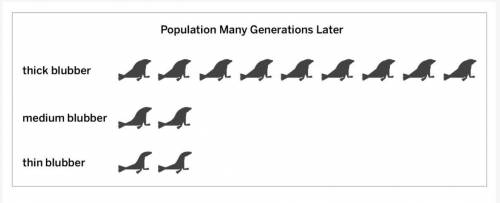
Social Studies, 20.04.2021 19:10 Will1119
Harbor seals live in northern oceans and have a layer of blubber (fat) that keeps them warm. Seals can have blubber of different thicknesses.
Seals with thicker blubber are more likely to stay warm and survive in cold ocean waters. But, in warm ocean waters, thicker blubber can make the seals overheat and die.
(First picture)
Harbor seals live in northern oceans and have a layer of blubber (fat) that keeps them warm. Seals can have blubber of different thicknesses.
Seals with thicker blubber are more likely to stay warm and survive in cold ocean waters. But, in warm ocean waters, thicker blubber can make the seals overheat and die.
Diagram titled Population Before containing 2 rows of seal icons. The first row is labeled Medium Blubber and contains 2 seal icons. The second row is labeled Thin Blubber and contains 9 seal icons.
The diagram above shows a population of seals that lived in an area of ocean. Scientists had previously only seen seals with medium or thin blubber in this area of ocean; they had never seen seals with thick blubber.
The diagram below shows how the population changed after many generations.
(second picture)
Edin says the change in the seal population was caused by a change in the environment.
Vada says the change was caused by a mutation.
Miko thinks both Edin and Vada are correct.
Who do you think is right? Explain what happened to the seals over many generations.



Answers: 1
Another question on Social Studies

Social Studies, 21.06.2019 21:30
Is british society today better than it was 400 years ago?
Answers: 1

Social Studies, 23.06.2019 04:00
In 1914, alabama produced 1.7 million bales of cotton, but three years later produced only 515,000, bales. meanwhile, in georgia, 5.2 million acres of land was dedicated for cotton production in 1914, but by 1923 there were just 2.6 million acres used for growing cotton. all of this was the result of the work of a tiny insect: the boll weevil. alabama and georgia first felt the effects of the boll weevil at different times. what would account for this difference in timing? a) the infestation moved from west to east. b) the infestation moved from east to west. c) georgia had better ways to deal with the problem. d) alabama was further from the insect's point of origin.
Answers: 3

Social Studies, 23.06.2019 06:00
What natural resource from west africa had a significant im pact on the growth of ghana
Answers: 2

Social Studies, 23.06.2019 08:30
Lance is a member of the professional organization iceaa. he always attends its annual conferences because it provides a great opportunity for with members of the same profession. in addition to the conference, iceaa organizes for members who are seeking better employment opportunities.
Answers: 3
You know the right answer?
Harbor seals live in northern oceans and have a layer of blubber (fat) that keeps them warm. Seals c...
Questions

History, 02.03.2021 01:00



History, 02.03.2021 01:00

Computers and Technology, 02.03.2021 01:00

Mathematics, 02.03.2021 01:00

Mathematics, 02.03.2021 01:00





Mathematics, 02.03.2021 01:00


Mathematics, 02.03.2021 01:00

Chemistry, 02.03.2021 01:00







